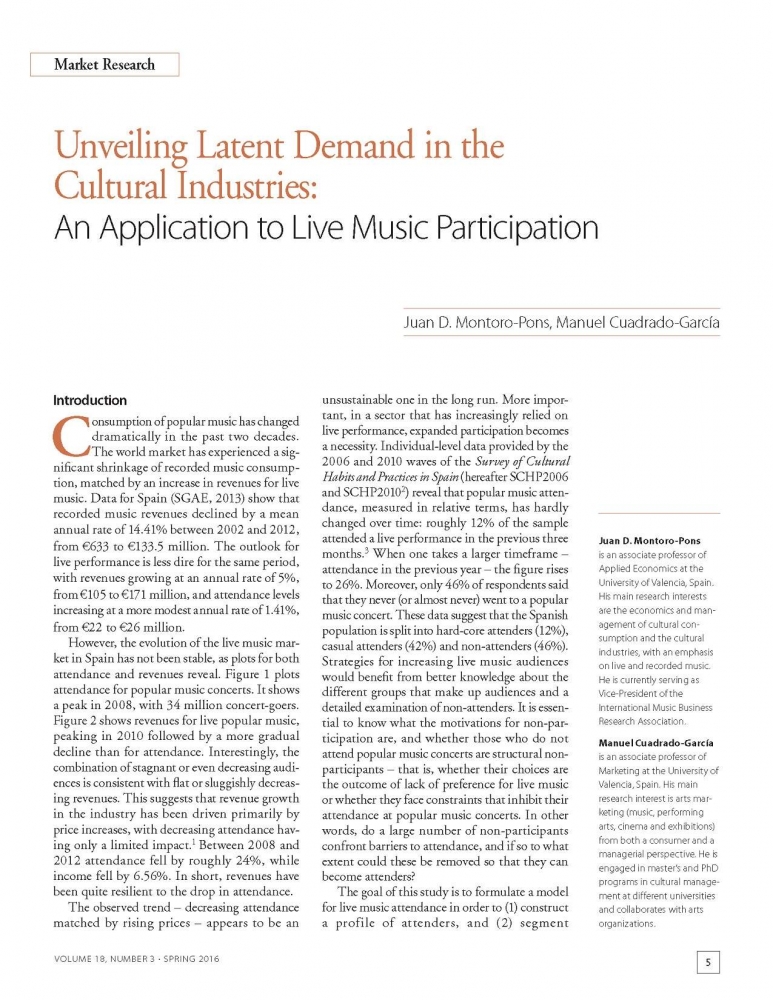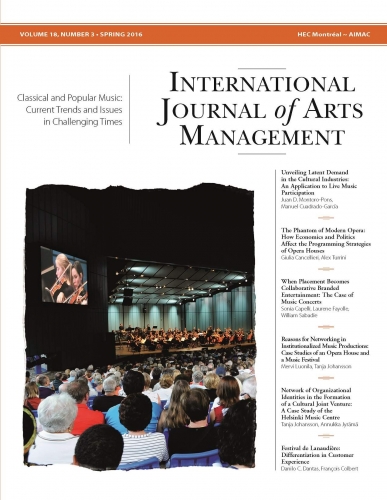Unveiling Latent Demand in the Cultural Industries: An Application to Live Music Participation
Product: Article
$21.00 CA
Juan D. Montoro-Pons, Manuel Cuadrado-García
Juan D. Montoro-Pons is an associate professor of Applied Economics at the University of Valencia, Spain. His main research interests are the economics and management of cultural consumption and the cultural industries, with an emphasis on live and recorded music. He is currently serving as Vice-President of the International Music Business Research Association.
Manuel Cuadrado-García is an associate professor of Marketing at the University of Valencia, Spain. His main research interest is arts marketing (music, performing arts, cinema and exhibitions) from both a consumer and a managerial perspective. He is engaged in master’s and PhD programs in cultural management at different universities and collaborates with arts organizations.
ABSTRACT
While the profile of popular music attenders has been widely analyzed, that of non-attenders is usually ignored. The purpose of this article is to describe and segment live popular music audiences with an emphasis on the identification of potential participants – that is, those who do not attend but would attend under the right circumstance. The authors statistically analyze the consumption of live popular music using secondary data from the 2010–11 Survey of Cultural Habits and Practices in Spain. Using their findings, they classify the public as actual attenders, potential attenders and never-goers. It is the second group, potential attenders, that is the most interesting, as enticing this segment to be full participants would increase the overall audience for live music. Marketing strategies are suggested.
KEYWORDS
Cultural capital, consumer behaviour, hedonic consumption, segmentation, non-attendance, media-based participation
RÉSUMÉ
Bien que l’on ait amplement commenté le profil des adeptes de concerts de musique populaire live , on a passé sous silence celui des personnes qui s’en désintéressent. Cet article décrit et répartit en segments l’auditoire des concerts de musique live en établissant les caractéristiques des spectateurs potentiels, soit ceux qui n’assistent pas à ces prestations mais qui le feraient si les circonstances étaient favorables. Les auteurs procèdent à une analyse statistique de la consommation de concerts de musique live à partir de données secondaires tirées d’une enquête menée en 2010-2011, Survey of Cultural Habits and Practices in Spain. À partir de leurs observations, ils répartissent l’auditoire en trois catégories : spectateurs convaincus, spectateurs potentiels et non-spectateurs. Le second groupe se révèle le plus intéressant, celui-ci pouvant grossir les rangs de l’auditoire de concerts de musique live si l’on suscite son intérêt. Les auteurs proposent des stratégies de marketing.
MOTS CLÉS
Capital culturel, comportement des consommateurs, consommation hédoniste, segmentation, non-participation, participation axée sur les médias
RESUMEN
El perfil del público que asiste a conciertos de música popular se ha extensamente analizado, mientras que se suele no tener en cuenta el de las personas que no asisten a ellos. El propósito de este artículo es describir y segmentar las audiencias de música popular en vivo haciendo particular hincapié sobre la identificación de participantes potenciales, es decir todas aquellas personas que no asisten a dichas actuaciones, pero que lo harían en circunstancias propicias. Los autores realizaron un análisis de las estadísticas sobre el consumo de música popular en directo presentadas en la Encuesta sobre las costumbres y prácticas culturales en España 2010-2011, en base del cual dividen el público en espectadores reales, espectadores potenciales y aquellos que nunca asisten. El segundo grupo, el de los espectadores potenciales, suscita el mayor interés, ya que al hacer que este grupo participe plenamente aumentaría la audiencia total. Se sugieren estrategias de comercialización con tales fines.
PALABRAS CLAVE
Capital cultural, comportamiento del consumidor, consumo hedónico, segmentación, falta de asistencia, participación por vía mediática

